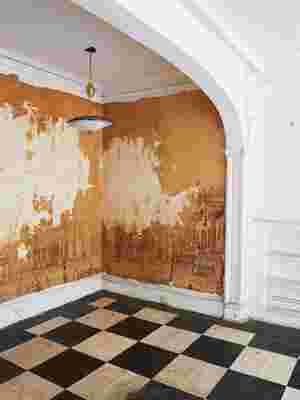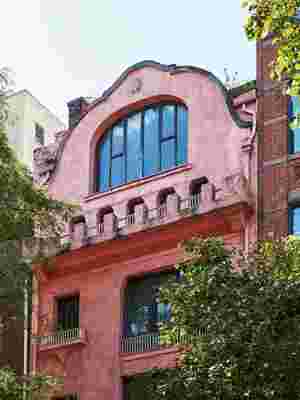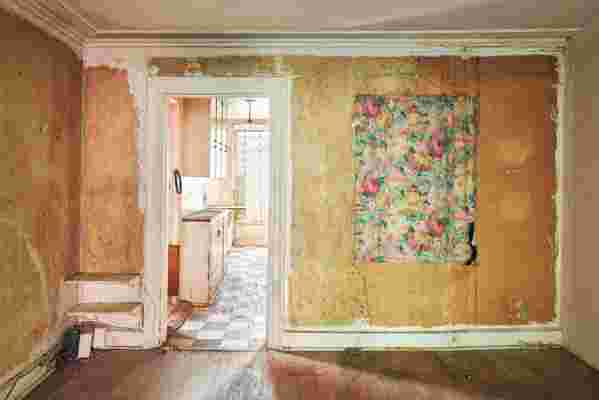A few steps from Washington Square Park, a four-story Art Nouveau townhouse has stood since 1826 amidst a block of similar structures. Passersby might not even pause were it not for the bright pink paint covering its stucco façade. More unusual still—particularly in the heart of renovation-rich Greenwich Village—is the fact that the original interiors were, until very recently, almost entirely untouched. That was thanks in large part to Celeste Martin, the home’s third-ever owner. News outlets lit up last spring when the eccentric 98-year-old died, leaving behind the house as well as other neighborhood real estate with a total value north of $25 million. Martin had “held court in the ‘pink house’ amid an army of roving cats and cast-off stage costumes from her days as a Rockette,” reported the New York Post in an unorthodox obit.
“The first time I actually came to see the house, she had passed away that very day,” says Cortney Novogratz, who, along with her husband Robert and their seven children, is the new owner of the Waverly Place manse. “It felt like it was meant to be.” The Novogratz, as they’re widely known—thanks to an eponymous line of furniture and home accessories, two popular reality TV shows, three coffee-table tomes, and a spate of high-profile projects on both coasts—intend to respect the property’s storied past while imbuing it with their trademark touch.

"This was a really rare building that you couldn't compare to anything else in Manhattan," comments Cortney of the property, which she and Robert had had their eye on for some 25 years. The large first floor, which opens onto the back garden, will become an open kitchen/dining/living space.

The Novogratz plan to keep the four-story home's exterior painted pink, although they are considering toning down its intensity, if the Landmarks Preservation Commission will allow. "It's really rare to find something that's been untouched like that for so many years," Cortney says.
“We both feel the house has a really good aura about it,” Robert says of the place, with its warren of rooms that feature wall colors as eye-catching as its exterior. “We want to keep that vibe—it’s who we are.”
The home’s distinctive tone is set the moment one enters the front door. Inside, the first floor, marked by its black-and-white checkered floor, feels expansive, flooded with light from a wall of southerly windows. Immediately one can sense that this parlor space, with its 14-foot ceilings, has been the backdrop for countless gatherings over the years. “It’s very grand in a casual, comfortable way,” Cortney says of the entry level, where a large open-plan kitchen and dining area will ultimately look down into the back garden.
Instead of building onto the back of the home, something any New York developer might advise to increase livable square footage, the Novogratz want to keep the backyard as expansive as possible. Having spent the past few years living in L.A., where they currently have an ongoing renovation project, the family appreciates the almost suburban feel that a townhouse affords in New York. “It’s easier to have seven kids in your own home than run them through a building and the elevators and neighbors that probably don’t appreciate them as much as we do,” says Robert, who, along with Cortney and their kids, has recognizable star quality. (Their eldest son, Wolfgang, is an actor, most recently starring in Netflix’s The Last Summer .) “We find that people swing by all the time,” Cortney adds, “and that’s a lifestyle that we cherish and love, and it makes living in Manhattan so much easier.”

The family plans to revisit some of the original color schemes in the renovated spaces, albeit on a more muted scale. "The Novogratz believe your home should be a reflection of who you are: bespoke, personalized, and well-curated," reads the company's mission statement. The second floor, pictured here, will become the couple's master suite.
Robert says the top-floor artist's studio is the most unusual private space he's ever seen in New York. The couple plants to install a piano and regularly host events in the room, which leads to a balconied mezzanine and, behind that, a future bar space that leads to a rooftop garden.
The second and third floors are slated to comprise the master suite and bedrooms for their school-age children. (“It’s just nice that they have to pass us if they want to sneak out at night,” Cortney says, laughing.) The basement, which boasts surprisingly high ceilings, will become a quasi-apartment for the older kids, with a gym, bedrooms, living area, and its own kitchenette. The plan is to keep the stairwell placement as it is, tucked over on the east side, but the family is in the process of installing an elevator.
The home’s undeniable pièce de résistance is its top-floor vaulted artist’s studio, which has a balcony mezzanine, a fireplace, huge windows, and true wow factor. It’s here that Martin would famously stand on the balcony and throw beads to marchers in the Gay Pride Parade below. The Novogratz remarked on how they want to nurture that dynamic in the special space, where they plan to hold events for up to 200 people.
“We’re trying to bring back a lot of the history of [Waverly Place], back in the 1920s especially, when all the artists moved here,” Cortney says. “It really became very gay and progressive and amazing, full of creativity and writers—we’re really trying to keep that, sharing the space with so many other talented, cool people.”
The couple describes their design plans for the house as more “classic and old-school” than some of the other projects they’ve completed. They also plan to keep as many of the structure’s original details intact as possible. For the backyard, they want to channel the South of France, with lush yet simple vegetation and white pea gravel. Inside, they envision a riff on their favorite restaurant, in Paris, called Derrière. “It has a really great old feel,” Cortney says of the boîte’s eclectic style, “but it also has the ping-pong table where kids hang out and play.”
The ultimate resource for design industry professionals, brought to you by the editors of Architectural Digest
Asked if they’re daunted by the task before them, they both laugh. “We’ve turned gunshots into homes and we’ve tackled lots of different types of property—I mean, each one we’ve done from scratch,” Cortney says, before a thoughtful pause. “But this one? This one just spoke to us.”
